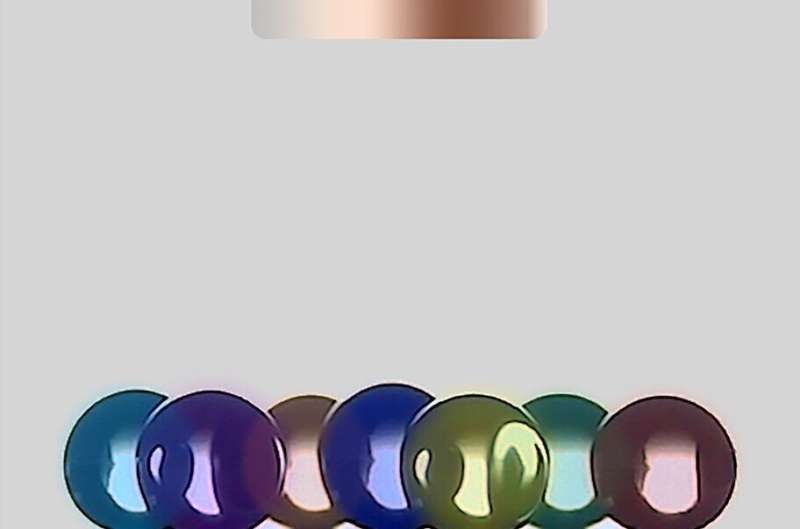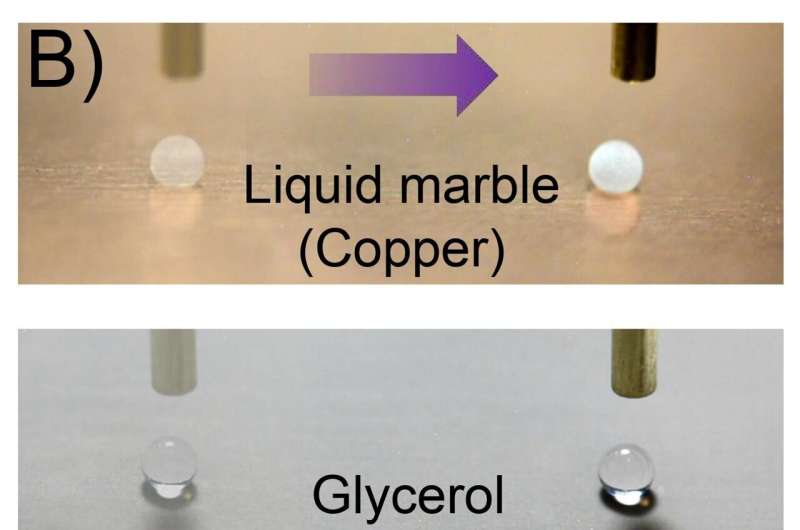The DEST can move droplets with volume from tens of nanoliters to several milliliters and move droplets in an array. Credit: Jin Yuankai et al
Droplet manipulation has important applications in areas such as heat management, water harvesting, and chemical reactions. A research team from City University of Hong Kong (CityU) developed a multi-functional electrostatic droplet tweezer that can precisely "trap" liquid droplets and remotely guide their motion on flat and tilted surfaces, and in oil mediums. Experiments showed that the tweezer can manipulate droplets of different volumes and with different components. It has potential applications in areas such as high-throughput biological and chemical analysis.
The research team is led by Professor Wang Zuankai, Chair Professor in CityU's Department of Mechanical Engineering (MNE). Their findings were published in the academic journal Proceedings of the National Academy of Sciences, under the title "Electrostatic tweezer for droplet manipulation."
The current approaches to manipulating droplets mainly take advantage of the surface force gradient constructed on the substrates or directly apply external force to the droplets. These methods always require the substrates or droplets to be responsive to external forces. Owing to the deformable nature of droplets, the existing methods for liquid manipulation face many technological challenges, such as short distance, low velocity, restricted operating conditions, and the need to add responsive additives to the droplets.
Manipulating droplets using static electricity
To overcome such technology constraints, Professor Wang and his team successfully developed a multi-functional droplet electrostatic tweezer that uses electrostatic induction to "attract" and remotely manipulate liquid droplets of different quantities, types and volumes up to a distance of a few centimeters. In short, the tweezer can move the droplets without directly touching them.
The DEST can move diverse types of droplets on electrically conductive substrates. Credit: Jin Yuankai et al/ DOI: 10.1073/pnas.2105459119
Inspired by the electrostatic induction of solid materials, the research team applied electrostatic induction in a liquid to achieve droplet manipulation. Electrostatic induction refers to the redistribution of electric charges in a conductor, caused by the influence of external electric charges. Eventually, the team successfully developed the droplet electrostatic tweezer (DEST) technology, eliminating the need for additives and achieving programmable droplet manipulation without directly contacting the droplets.
The DEST system consists of two parts: a tweezer with an external voltage applied on the electrode tip, and a substrate, which is electrically grounded. Droplets are put on the substrate, and when the the electrostatic tweezer is connected to power, the electric charges of the droplets and substrate are redistributed due to electrostatic induction. This allows the electrostatic tweezer to precisely "trap" the droplets and guide them towards the electrodes at the tip with an appropriate voltage.
"The DEST is programmable," said Professor Wang. "Our experiments showed that the DEST can guide the movement of the liquid droplets in open spaces, closed channels and even oil. The DEST also allows us to maneuver droplets from tens of nanoliters to several milliliters, and different quantities," said Professor Wang.
(Video 1) DEST can guide the movement of liquid droplets in open spaces, closed channels and even oil. Credit: Jin Yuankai et al/ DOI: 10.1073/pnas.2105459119
Different DEST manipulating modes
The research found that DEST can achieve different modes. For example in the guiding mode, the droplet follows the movement of the tweezer with the electrode on its tip. In the trapping mode, the droplet moves toward the stationary tweezer with the electrode "switched on." Changing the "on" or "off" state of the electrode of the tweezer allows the droplet to move to or stay at the desired position of the tweezer. When the electrode of a tweezer is "off" but the neighboring one is "on," the droplet moves to the "on" tweezer, achieving directional movement (video 2).
In the continuous trapping mode of the DEST, since all the electrodes of the tweezer are "on," the droplet continuously move to the next "on" tweezer (video 3).
(Video 2) High-speed camera snapshots show that in the trapping mode of the DEST, the droplet moves toward the stationary tweezer with the “on” electrode. By changing the electrodes’ state, the droplet can be moved to the desired tweezer. Credit: Jin Yuankai et al/ DOI: 10.1073/pnas.2105459119
Compared to other droplet manipulation technologies, the DEST achieves precise and programmable droplet manipulation with high velocity, unlimited distance, and agile direction steering. The technology offers a potential platform for using droplet manipulation for chemical reactions, such as precipitation reactions and color reactions. DEST can also be applied to carry small solid objects, and to conduct selective surface cleaning and high-throughput surface enhanced Raman spectroscopy detection.
(Video 3) In the continuous trapping mode of the DEST, all tweezers are “on”. The time-lapse video shows that the droplet continuously moves from the first tweezer to the fourth tweezer. Credit: Jin Yuankai et al/DOI: 10.1073/pnas.2105459119
"We also prepared a superhydrophobic substrate functionalized with silver nanoparticles, so that when the manipulated droplets move on this substrate, they carry the silver nanoparticles. This enhanced the sensitivity in the Raman measurement owing to the plasmonic properties of the silver nanoparticles in the droplets. When one droplet is measured and removed by the electrostatic tweezer, subsequent droplets can be moved to the laser position for another measurement, and the measurement results do not interfere with each other. Another advantage of the DEST in assisting Raman measurement is that it eliminates the need for precise laser focusing on the droplet, thus greatly shortening the measurement time and achieving high-throughput droplet information detection," explained Dr. Jin Yuankai, Postdoc in the MNE and first author of the paper.
(Video 4) The DEST can be harnessed to activate chemical reactions with trace amounts of reactant, carry small objects, and conduct selective surface cleaning. Credit: Jin Yuankai et al/DOI: 10.1073/pnas.2105459119
"Our technology increased the controllability and broadened the application scenarios of droplet manipulation, and simplified the application process. In addition, the substrates used in our DEST system can be functionalized, enhancing their performance for chemical and biological analysis," concluded Professor Wang on their research findings.
More information: Yuankai Jin et al, Electrostatic tweezer for droplet manipulation, Proceedings of the National Academy of Sciences (2022). DOI: 10.1073/pnas.2105459119
Journal information: Proceedings of the National Academy of Sciences
Provided by City University of Hong Kong
























